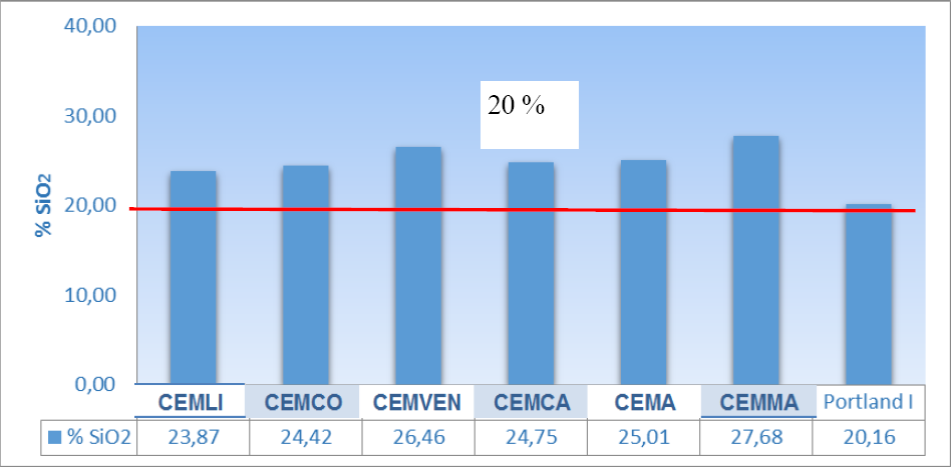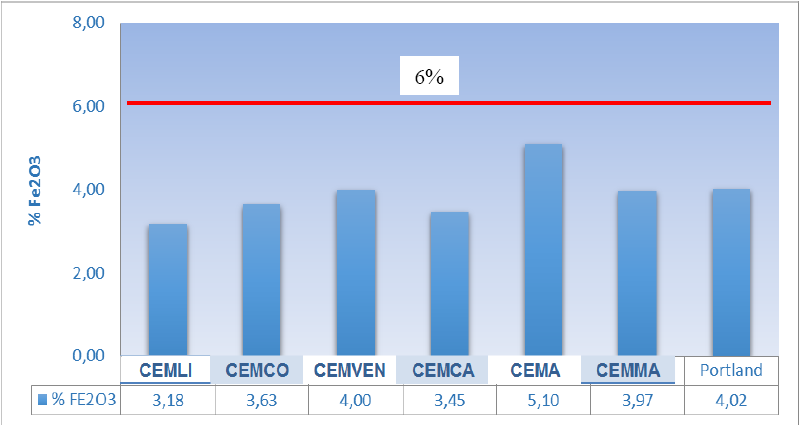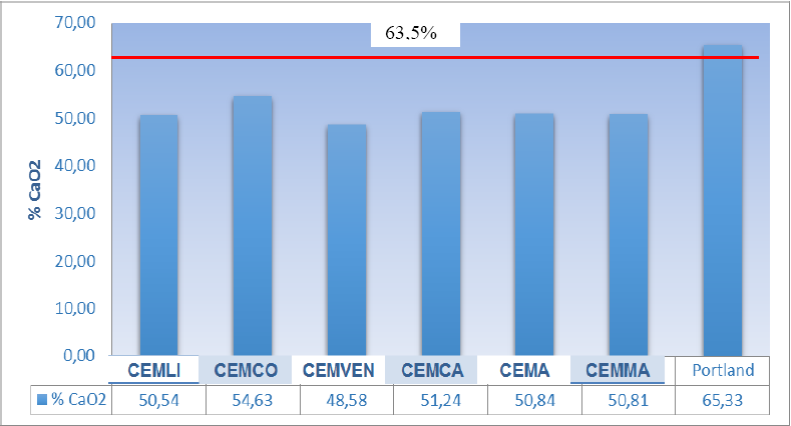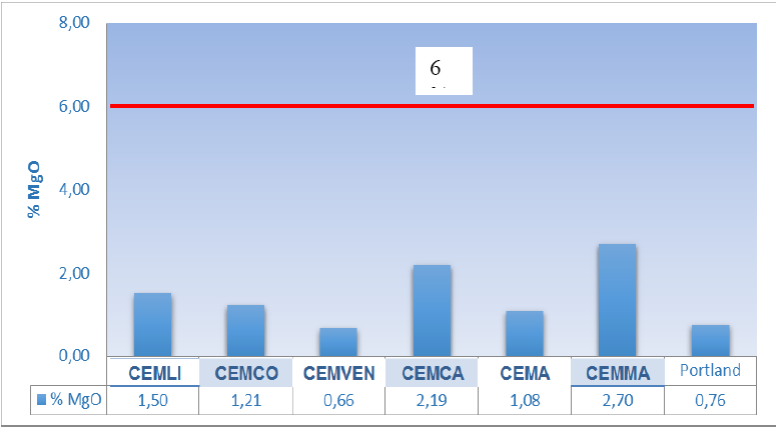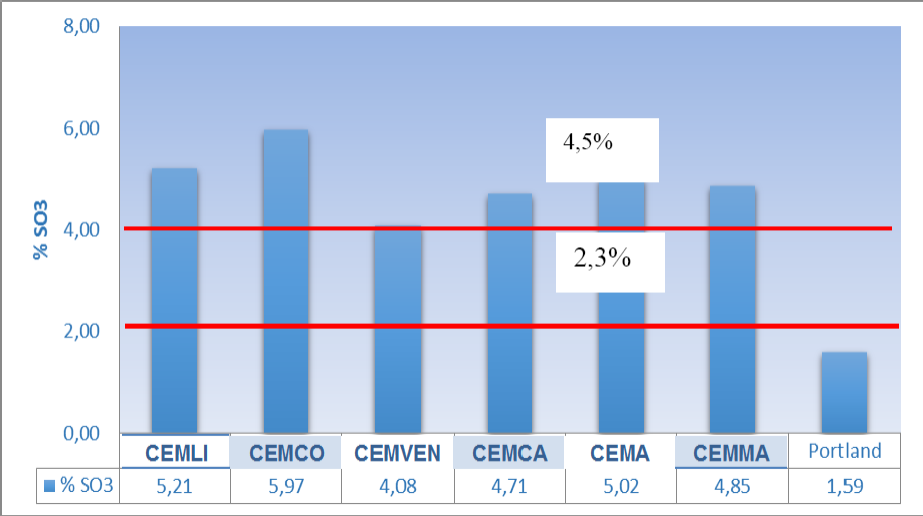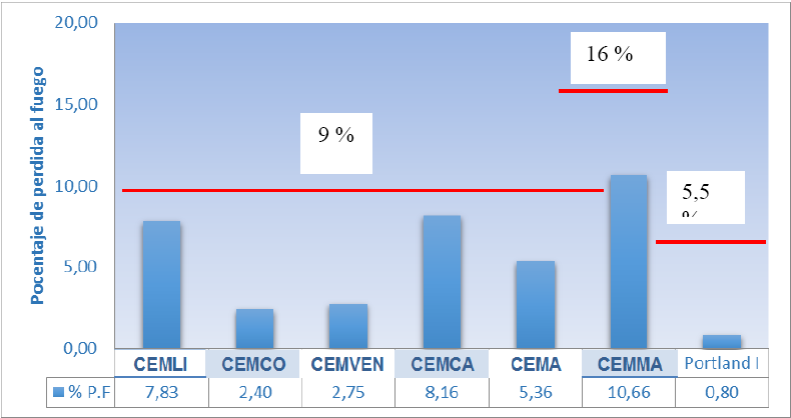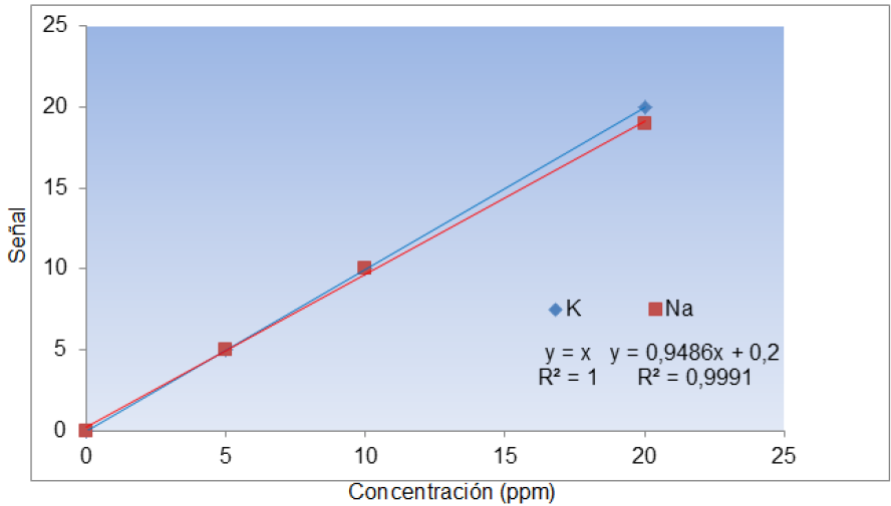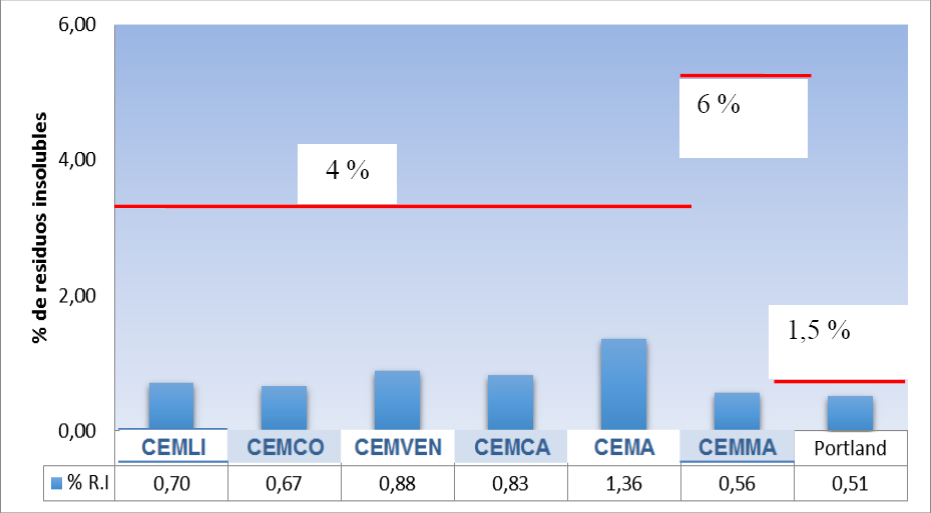Serviços Personalizados
Journal
Artigo
Indicadores
-
 Citado por SciELO
Citado por SciELO -
 Acessos
Acessos
Links relacionados
-
 Similares em
SciELO
Similares em
SciELO
Compartilhar
Revista ALCONPAT
versão On-line ISSN 2007-6835
Rev. ALCONPAT vol.5 no.3 Mérida Set./Dez. 2015
Articles
Chemical and physical-mechanical characterizations of cement with the addition of limestone filer in Venezuela
1 Universidad Centroccidental "Lisandro Alvarado", Barquisimeto, Venezuela, Asociación Latinoamericana de Control de Calidad, Patología y Recuperación de la Construcción - Capítulo Venezuela,
2 Universidad del Zulia, Maracaibo, Venezuela, Centro de Estudios de Corrosión oladis1@yahoo.com
In recent years in Venezuela, there has been a crisis on demand, production and marketing of cement, primary building material. In this work the chemical and physical mechanical characterization made a Top Trademark blended cements in the country, characterizing them according to: chemical composition, Blaine fineness, setting time and compressive strength. The results show that these cements do not meet the minimum requirements established in the Venezuelan standard for use in the manufacture of structural concrete.
Keywords: Blended cement; Corrosion; Reinforced Concrete
En los últimos años en Venezuela, se ha presentado una crisis sobre la demanda, comercialización y producción del cemento, principal material de construcción. En este trabajo se presentará la caracterización química y físico- mecánica realizada a las principales marcas comerciales de cementos adicionados en el país, caracterizándolos de acuerdo a: composición química, finura Blaine, tiempo de fraguado y resistencia mecánica a compresión. Los resultados demuestran que estos cementos no cumplen con los requisitos mínimos establecidos en la norma venezolana para su uso en la elaboración de concreto estructural.
Palabras clave: Cemento Adicionado; Corrosión; Concreto Armado
Nos últimos anos na Venezuela, tem-se apresentado uma crise sobre a demanda, comercialização e produção de cimento, um dos principais materiais de construção. Este artigo apresentará a caracterização química e físico-mecânica realizada nas principais marcas de cimentos com adições comercializados no país, caracterizando-os de acordo com a sua composição química, finura Blaine, tempo de pega e resistência à compressão. Os resultados demonstram que estes cimentos não cumprem com os requisitos mínimos estabelecidos na norma venezuelana para a sua aplicação na elaboração de concreto estrutural.
Palavras-chave: Cimento com adições; Corrosão; Concreto Armado
1. INTRODUCTION
Over the last few years, there has been a crisis regarding the demand, commercialization and production of cement, a basic construction material in Venezuela. This has led manufacturers to seek alternatives in order to meet this growing demand, consequently including in the commercial offering of this material cement aggregates. These aggregates are usually the Portland type with the addition of limestone, with a concentration varying between 15% and 30% based on the weight of the cement.
Even though the production of cement aggregates is a global phenomenon that aims, among other things, to reduce the environmental impact of the production of Portland cement and to decrease the emissions of CO2 in the construction industry, the indiscriminate use of this product in Venezuela has been noted as the technical limitations of this cement have not been considered, mainly in regards to mechanical resistance and their reaction to corrosion of reinforced concrete. The latter is addressed in our hypothesis on the basis of the chemical composition of these cements, which prevents not only a lower alkaline reserve which would make them less resistant to the action of environmental agents, more specifically carbonation, but also their inability to guarantee the adequate mechanical resistance for the design of conventional mixtures.
Cement aggregates (or reinforced) are Portland cement clinker mixtures, calcium sulphate (plaster) and aggregates. These cements can be produced through the joint grinding of these components or through the mixing of grinded components (Salamanca 2000). Type CPCA 1 and CPCA 2 cement aggregates are formulated for their use in the production of concretes and mortars that need to improve their workability, water retention ability, appropriate resistance on use and greater durability (Salamanca 2000). According to the Venezuelan standard COVENIN (COVENIN 3134-2004/ASTM C-150), the CPCA 1 is that whose content of limestone or any other calcareous material is more than 15% and less than or equal to 30% of its total weight.
As mentioned before, it is important to know the nature and the physical-mechanical characteristics of these cements, as the achievement of the established characteristics for their use as structural concrete, one that is resistant and durable, will depend upon them. The problems that arise from the incorrect use of concretes elaborated with different types of cements without taking any precautions make it necessary to look into the materials to be used and the transformation products generated in the manufacturing of concretes.
Venezuelan law does not designate particular conditions for the characteristics of cements with limestone additions, and does not regulate the chemical requirements as it does with standardized Portland cement. For cement aggregates, the COVENIN 3134-04/ASTM C-150 standard establishes the physical, chemical and mechanical requirements to be followed, mandating the same physical-mechanical requirements that have been established for Portland cement type I and only three parameters for the the chemical requirements among which the following can be found: loss on ignition, insoluble residues and sulphur trioxide (SO3). However, these components are not the only ones that guarantee the quality of the cement. For this reason, the existing chemical parameters in the current COVENIN 109-90/ASTM C-114 standard should be applied to the cement aggregates. This standard contemplates the test methods employed to perform chemical analyses of hydraulic cements, which are fundamental for the determination through the Bogue method of the main chemical components: alite, belite, tricalcium aluminate, and tetra-calcium aluminoferrite. Due to all of the aforementioned, it is necessary to determine the technical limitations of the use of these cements in the manufacturing of concrete for structural elements, which will undoubtedly contribute to the improvement of the durability of the buildings in the country. Thus, this work is oriented towards the determination of the chemical and physical-mechanical characteristics of the cement aggregates of the different companies that manufacture this material in Venezuela, that allow the estimation of their behavior as structural concrete.
2. EXPERIMENTAL PROCEDURE
The following materials were used: Portland cement type I, cement aggregates with limestone filer CPCA from six different companies in the country (identified as CEMA, CEMCA, CEMCO, CEMLI, CEMVEN and CEMMA), and standardized silica in compliance with the Venezuelan COVENIN 2503/ASTM C-778 standard. For the mixture design, the recommendation by the ACI 211 was used.
For the evaluation of the chemical and physical-mechanical properties, the validation criteria for cement aggregates described in the COVENIN 3134-04 (ASTM C-ASTM C-150) were used through the following tests: chemical analysis (COVENIN 109-90/ASTM C-114), Blaine fineness (COVENIN 487/ASTM C-204), setting time (COVENIN 493:1992/ASTM C-19) and resistance to compression (COVENIN 484:1993/ASTM C-109). In relation to the number of samples in each test, the amount established in each standard was used as a minimum.
For the chemical analysis of cement aggregates, the COVENIN 109-90/ASTM C-114 standard indicates that platinum crucibles should be used. One of the limitations of this work was the lack of availability of these crucibles; it was therefore decided to use conventional ceramic crucibles with a capacity of 15 cm3 and 30 cm3.
3. RESULTS AND DISCUSSION
3.1. Physical-mechanical characterization of CPCA cement aggregates
The most relevant results of the physical-mechanical characterization done to six commercial brands of CPCA type cements manufactured in Venezuela are presented.
Six (6) samples for each type of cement were tested for fineness through the Blaine's permeability meter in regards to the fineness of standardized cement; results are shown in Table 1. This table shows that in all evaluated cases the determined fineness values of Portland cements with CPCA additions exceed the minimum normative value established (3000 cm2/gr), which also indicates a larger specific surface for better hydration to the specific surface required for its hydration.
Table 1 Results of the fineness determination (specific surface) of the Portland cement with CPCA aggregates, normative value (minimum) of 300 cm2/gr.
| DETERMINATION OF BLAINE'S FINENESS (SPECIFIC SURFACE) | |
| CEMENT TYPE | FINENESS |
| CEMA | 3534,06 cm2/gr |
| CEMCA | 3602,17 cm2/gr |
| CEMCO | 3093,08 cm2/gr |
| CEMLI | 3827,47 cm2/gr |
| CEMVEN | 3246,46 cm2/gr |
| CEMMA | 3588,06 cm2/gr |
| PORTLAND I | 3867,06 cm2/gr |
It is important to note that one of the last stages in the manufacturing of cement is the mixture of the grinded clinker with hydrated calcium sulphate. That said, as hydration begins on the surface of the cement grains, its superficial area constitutes the material of hydration. In this manner, the speed of hydration depends on the fineness of the cement particles; therefore, for a quick development of resistance, a high level of fineness is necessary. However, the grinding of cement particles in order to obtain more fineness represents a considerable expense. It is required for the cement to achieve the necessary resistance to different ages through the clinker quality and not through the fineness of the grinding.
It should also be noted that in Venezuela the usual cements are grinded to Blaine's fineness on the order of 2800 to 3500 cm2/gr. When it exceeds 4000 cm2/gr, and depending on the chemical composition of the cement, secondary problems may arise on the concrete, such as difficulty in the mixing of it and more retraction. These results are therefore considered acceptable due to the fact that the values obtained from the Portland cement with CPCA aggregates in the study exceed the minimum established by the COVENIN 3134:2004 standard, without reaching inadequate fineness values (>4000 cm2/gr).
The average results of nine (9) samples of each type of tested cement obtained through the determination of the initial setting time and final setting time of the cement are shown in Table 2. As it is already known, the setting time is that in which a binder changes its initial plasticity to a stony state, making this a fundamental property for these types of materials, as it establishes the average time of workability and placement without affecting the development of its final properties. It can be observed in this table that for Portland cement with CPCA aggregates, in all evaluated cases, the values of minimum initial time determined do not achieve the standard value that has been established. This results in the non-compliance of this characteristic of the material, inferring potential difficulties in the manufacturing of concretes and mortars due to the low setting time that was determined. In contrast, the behavior of Portland cement type I showed results similar to what was expected.
Table 2 Results of the characterization of Portland cements with CPCA aggregates. Determination of setting time.
| DETERMINATION OF SETTING TIME | ||||
| Cement | Initial Time (min) | Final Time (min) | Normative Value | |
| Minimum Initial Time (min) | Maximum Final Time (min) | |||
| CEMA | 30 | 255 | 45 | 480 |
| CEMCA | 30 | 165 | 45 | 480 |
| CEMCO | 40 | 180 | 45 | 480 |
| CEMLI | 40 | 165 | 45 | 480 |
| CEMVEN | 15 | 240 | 45 | 480 |
| CEMMA | 15 | 240 | 45 | 480 |
| PORTLAND I | 90 | 290 | 45 | 480 |
Even though the characteristics already mentioned reflect that the evaluated cement presents discrepancies with the normative values to be met, the quality of cement in building practices is measured based on its resistance to compression once it has set and hardened, this mechanical characteristic being the main evaluation factor of the binder. Therefore, this property was evaluated on the cements that were studied, putting together 18 cubic test tubes with cement mortar (cement to be evaluated and standardized silica sand) with sides of 50.8 mm for each type of cement and each age of assay (7 and 28 days).
Table 3 presents the results obtained from each test, obtaining results that confirm the non-compliance of the normative values for the evaluated cements.
Table 3 Resistance to compression of Portland cement with CPCA aggregates, 7 and 28 days.
| RESISTANCE TO COMPRESSION OF CPCA CEMENT AGGREGATES (kg/cm2) | |||||||
| Cement Days | CEMAN | CEMCA | CEMCO | CEMLI | CEMVE | CEMMA | PORTLAND I |
| 7 days (Average) | 117,73 | 149,06 | 46,29 | 93,06 | 127,75 | 132,89 | 296,63 |
| Deviation | +/- 4,50 | +/- 4,00 | +/- 7,76 | +/- 3,88 | +/- 4,83 | +/- 3,43 | +/- 3,21 |
| 28 days (Average) | 145,12 | 213,45 | 178,45 | 176,87 | 216,85 | 157,77 | 394,08 |
| Deviation | +/- 5,03 | +/- 4,07 | +/- 4,83 | +/- 3,76 | +/- 4,14 | +/- 4,73 | +/- 4,03 |
When observing the results, it is evident that the lowest average tested resistance for the test age (7 days) came from the CEMCO cement with a value of 46,29 kg/cm2, while the highest came from the CEMCA cement with a value of 149,06 kg/cm2. However, none of the evaluated cements reached the 170 kg/cm2, the value recommended by the COVENIN 3134:2004/ASTM C-150 standard for Portland cement with CPCA1 aggregates. A similar behavior was noticed when evaluating the resistance to compression at 28 days where none of the evaluated cements achieved the normative value of 280 kg/cm2; these were all surpassed by control Portland cement type I. This undoubtedly compromises their performance as structural concrete. Starting from the premise that the material does not possess the minimum conditions, its evolution should not be able to achieve the expected values. This is why it was considered to characterize them chemically in order to determine the components that are contributing to their failure to meet high compression resistance.
3.2. Chemical characterization of the main and secondary components of CPCA cement aggregates
3.2.1 Main components of cement aggregates
Silicon Dioxide (SiO 2 ).- Double calcination of the sample was done during this test, and the residue therefrom was used in the determination of the group of ammonium hydroxide. Figure 1 shows the average of the results that were obtained.
The obtained values indicate that Portland cement had a value of 20.16% and all the other samples possessed more than the 20% of silicon dioxide, the minimum established parameter in the COVENIN 28-93/ASTM C-150 standard for Portland cement type II; the standard does not specify the content of this component for Portland I. All values are set within a range between 20% and 30%, with the lowest percentage being Portland cement type I.
Aluminum Oxide (Al 2 O 3 ).- In this determination, as indicated by the COVENIN 109-90/ASTM C-114 standard, the quantity of ferric oxide is subtracted from the value obtained by the ammonium hydroxide study. All studies complied with the variation parameter allowed by the standard to ensure the reliability of the study. The total % results of Al2O3 are shown in Figure 2.
The results obtained indicate that all samples are above the value accepted by the standard for Portland cements type II, which should be less than 6%. The Portland type I and CEMLI samples are the closest to this value with 6.8% and 8.3%, respectively. On the other hand, CEMCO and CEMVEN possess the highest percentage of Al2O3 (20.15% and 19.96%, respectively). Porrero (2004) mentions that the values for this parameter of Portland cement are between 3.5% and 8%, parameter which the cement aggregates exceed.
Ferric Oxide (Fe 2 O 3 ).- The percentages of ferric oxide for each of the samples are detailed in Figure 3.
All analyzed samples are below the maximum value stipulated in the COVENIN 28-93/ASTM C-150 standard, the CEMA cement sample representing the highest percentage of ferric oxide with 5.10% and the CEMLI cement sample representing the lowest percentage of this component with 3.18%.
Calcium Oxide (CaO).
The results of the test were adjusted to a difference of 0.2 between the duplicates allowed by the COVENIN 109-90 standard. Figure 4 shows the results obtained of the % of calcium oxide.
This test does not possess a standardized value for comparison purposes. However, Porrero (2004) indicates values between 60% and 67% for Portland cement type I of excellent quality, with the evaluated cement aggregates below these values, with percentages between 48.58% and 54.63%.
Magnesium Oxide (MgO).- This test is done with the filtrates from the determination of calcium oxide, obtaining the values that are shown in Figure 5.
All the values are below the limit (6%) stipulated in the COVENIN 109-90/ASTM C-114 standard. It can be observed that the percentages of magnesium oxide are comprised between 0.66% for the CEMVEN sample and 2.70% for the CENMA sample.
Sulphur Trioxide (SO 3 ).- The results obtained for the duplicated values can be observed in Figure 6.
The minimum chemical requirements established in the COVENIN 28-93 standard dictate that the percentage of sulphur trioxide present in the Portland cement is not higher than a range between 2.3% and 4.5%. Figure 6 shows that only CEMVEN (4.08%) and Portland (1.59%) comply with this standard, as the rest of the samples contain higher quantities comprised between the range of 4.85% and 5.97%.
3.2.2 Special Tests
Loss on ignition of the cement.- This test represented one of the simplest as it only needed the sample to be burned at 950°C and then calculated the difference in weight.
Figure 7 shows the percentages of loss on ignition obtained during the test.
All the samples analyzed comply with the parameters established by the COVENIN standard. The loss on ignition values should be less than 9% for CPCA1, less than 16% for CPCA2 and less than 5.5% for Portland cement type I. The CEMLI and CEMCA cements with 7.83% and 8.16% respectively present the highest percentages of loss on ignition in comparison with the other samples.
3.2.3 Secondary Components
Sodium Oxide (Na 2 O) and Potassium Oxide (K 2 O).- For the determination of this component, a dilution 1:10 was done on all samples so that the reading could be accepted on the calibration line of the flame photometer. The calibration curve for the determination is shown in Figure 8.
As it can be observed in Figure 8, both Na and K show an excellent linearity index. The results obtained (Table 4) for the value limits of the duplicates indicate that all concentrations of Na are below the maximum deviation allowed, which is 0.03%. In the case of K, 72% of the results are below 0.03% which is the accepted value. Only CEMCO and CENMA do not comply with a percentage of 0.04%; however, they do not duplicate the accepted limit and therefore comply with the standard.
Table 4 Results obtained in the determination of Na2O and K2O in the different cements evaluated.
| Sample | σ*Na | σ*K | N.C 109-90** | %Na 2 O*** | %K 2 O*** |
| CEMLI | 0,00 | 0,02 | 0,03 | 0,11 | 0,38 |
| CEMCO | 0,00 | 0,04 | 0,03 | 0,11 | 0,31 |
| CEMVEN | 0,00 | 0,00 | 0,03 | 0,17 | 0,67 |
| CEMCA | 0,01 | 0,02 | 0,03 | 0,12 | 0,36 |
| CEMA | 0,00 | 0,00 | 0,03 | 0,11 | 0,67 |
| CEMMA | 0.01 | 0,04 | 0,03 | 0,12 | 0,45 |
| Portland I | 0,00 | 0,00 | 0,03 | 0,16 | 0,51 |
* Standard deviation among duplicates
** COVENIN 109-90/ASTM C-114 standard
*** Arithmetic measure of the %
Table 4 also indicates that the highest % of Na2O comes from CEMVEN cement with 0.17% and the lowest from CEMLI, CEMCO and CEMA with 0.11%. On the other hand, Portland cement has a percentage of 0.16% of Na2O which is in the aforementioned range. The highest % of K2O comes from CEMVEN and CEMA cements with 0.67% and the lowest from CEMCO with 0.31%. Meanwhile Portland cement has a 0.52% of K2O, which is within the aforementioned range.
3.2.4 Insoluble Residue (I.R.)
In this case study, more than 70% of the duplicate tests comply with the parameter established by the COVENIN 109-90/ASTM C-114 since the variation of these tests is not higher than 0.1%; only the CEMAN and Portland samples presented higher percentages of 0.12% and 0.15%, respectively. Figure 9 shows these results.
Based on the results obtained, it can be observed that all samples comply with the parameters established by the COVENIN standard regarding insoluble residues for cements, with percentages lower than 4% for CPCA1, lower than 6% for CPCA2 and lower than 1.5% for Portland type I . Among the data it can be noted that in the majority of cases the insoluble residue % of the samples is below 1%, with the exception of CEMAN which slightly surpasses 1%. If all samples were to be compared in regards to the COVENIN 3134-04/ASTM C-150 standard for Portland cement, they would also comply with this parameter.
Table 5 shows all the results of the chemical characterization of the different cements evaluated. As already mentioned, it can be observed that the concentrations of some of these components are outside the specifications of the COVENIN standard.
Table 5 Chemical characteristics of the CPCA1 and CPCA2 cement aggregates
| Sample | SiO 2 | Al 2 O 3 | F e2 O 3 | CaO | MgO | SO 3 | P.F | K 2 O | Na 2 O | R.I |
| CEMLI | 23,87 | 8,43 | 3,18 | 50,54 | 1,50 | 5,21 | 7,83 | 0,38 | 0,11 | 0,70 |
| CEMCO | 24,42 | 20,15 | 3,63 | 54,63 | 1,21 | 5,97 | 2,40 | 0,31 | 0,11 | 0,67 |
| CEMVEN | 26,46 | 19,96 | 4,00 | 48,58 | 0,66 | 4,08 | 2,75 | 0,67 | 0,17 | 0,88 |
| CEMCA | 24,75 | 17,38 | 3,45 | 51,24 | 2,19 | 4,71 | 8,16 | 0,36 | 0,12 | 0,83 |
| CEMA | 25,01 | 18,75 | 5,10 | 50,84 | 1,08 | 5,02 | 5,36 | 0,67 | 0,11 | 1,36 |
| CEMMA | 27,68 | 13,61 | 3,97 | 50,81 | 2,70 | 4,85 | 10,66 | 0,45 | 0,12 | 0,56 |
| Portland I | 20,16 | 6,88 | 4,02 | 65,33 | 0,76 | 1,59 | 0,80 | 0,51 | 0,16 | 0,51 |
It is important to note the high and low contents of aluminum oxide and calcium oxide, respectively, in the majority of the evaluated cements, which in the proportions obtained generate certain limitations for the manufacturing of structural concrete, particularly regarding the resistance to compression, which in all cases was always inferior to the one obtained with Portland I cement. The low rates of CaO do not allow the formation of C3S and C2S in sufficient amounts to be able to generate a resistance to compression that is equal or as high as the one obtained with Portland I.
In addition, the high content of Al2O3 is related to the low setting time determined for the different types of cement aggregates due to the potential formation of high contents of C3A, which would also increase the susceptibility to sulphate attacks which is very important in constructions in marine environments.
Finally, it is important to note that it seems contradictory for the norms to demand from these cement aggregates physical-mechanical requirements similar to those of Portland I cement when their chemical composition is significantly different as shown in the results of this work.
4. CONCLUSIONS
Type CPCA cement aggregates manufactured in Venezuela and evaluated in this research do not comply with the minimum requirements established in the Venezuelan standard for their use in the elaboration of structural concrete.
The use of these cements in the elaboration of structural concretes could degenerate in premature pathological manifestations.
The contents of aluminum oxide, calcium oxide and sulphur trioxide of the cement aggregates are outside of the specifications.
The percentages of additions used in the manufacturing of these cements directly affect their properties.
The results obtained regarding the determination of Al2O3 could be related to the results of the setting time.
Referencias
Bolognini, H y Colaboradores (2011) "Prevención de daños y rehabilitación de estructuras de concreto armado Un Enfoque integral..." Venezuela. p 196 [ Links ]
Bolognini H., Martínez N., Loizaga M., Castellar D.,Troconis O. (2013) "Caracterizacion quimica de cementos adicionados comercializados en Venezuela " in: V Conpat Nacional, Alconpat Venezuela: pp 1-12 [ Links ]
De la Torre A, Aranda M. (2005) Análisis mineralógico por difracción de rayos X y el método de Rietveld en la industria cementera. Cemento-hormigón (877) 489-505. [ Links ]
Garcia M, Blanco-Varela M, De la Torre A, Bruque S, Zuñigua F. (2003) Cuantificación mineralógica directa de cementos portland por el método de Rietveld. Cemento-hormigón (850) 4-5. [ Links ]
Le Saoût G, Kocaba V, Scrivener K (2011) Application of the Rietveld method to the analysis of anhydrous cement. Cement and concrete research (41) 2, 133-148. [ Links ]
McLaren D, White MA (2003) Cement: Its chemistry and properties. Journald of chemical education. (80) 623-635 [ Links ]
Norma COVENIN 109-90. Cementos hidráulicos. Métodos de ensayo para análisis químico. [ Links ]
Norma COVENIN 3134-04. Cemento Portland con adiciones. Requisitos. [ Links ]
Norma COVENIN 487:1993 (3era Revisión). Determinación de la Finura Blaine del Cemento. [ Links ]
Norma COVENIN 493:1992 (3era Revisión). Determinación del Tiempo de Fraguado (Vicat) [ Links ]
Norma COVENIN 484:1993 (3era Revisión). Determinación de la Resistencia a la Compresión del Cemento. [ Links ]
Joaquín Porrero (2004) Manual del concreto estructural. Caracas Venezuela [ Links ]
Salamanca R, Aplicación de los cementos portland y adicionados. Ciencia e Ingeniería Neogranadina, (010) 2000, 33-38 [ Links ]
Solís Carcaño Romel; Moreno I. Éric (2006): "Análisis de la porosidad de concreto con agregado calizo", Revista de la Facultad de Ingeniería Universidad Central de Venezuela, Caracas, Venezuela. [ Links ]
Tobón J, Kazes-Gómez R (2008) Desempeño del cemento portland adicionado con calizas de diferentes grados de pureza. Dyna (156) 177-184. [ Links ]
Troconis, O., y Otros. (1997). "Manual de inspección, evaluación y diagnóstico de corrosión en estructuras de concreto armado". Programa Iberoamericano de Ciencia y Tecnología para el Desarrollo. [ Links ]
Received: November 15, 2014; Accepted: July 18, 2015











 texto em
texto em 

